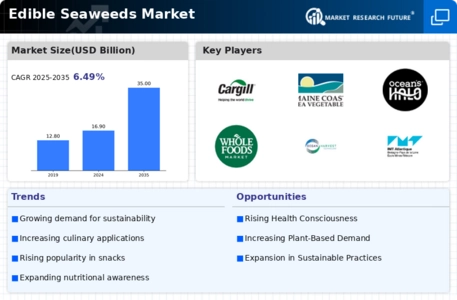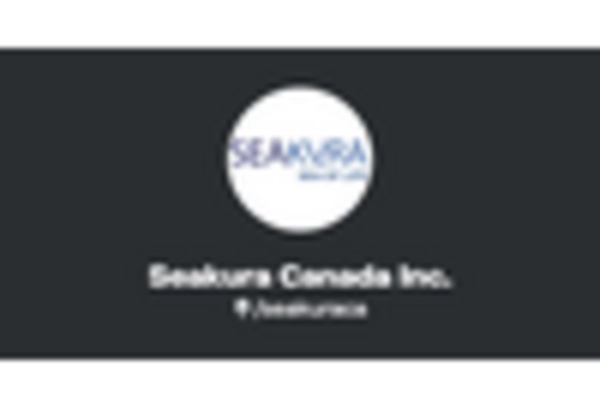Functional Food Trends
The trend towards functional foods is gaining momentum, influencing the Edible Seaweeds Market. Consumers are increasingly seeking foods that offer health benefits beyond basic nutrition, and edible seaweeds fit this criterion well. They are often fortified with bioactive compounds that may support various health functions, such as immune support and anti-inflammatory properties. The market for functional foods is projected to expand, with edible seaweeds likely to play a crucial role in this growth. As consumers become more health-conscious, the demand for functional seaweed products is expected to rise, thereby enhancing the Edible Seaweeds Market.
Health Benefits of Edible Seaweeds
The rising awareness of health benefits associated with edible seaweeds appears to be a primary driver in the Edible Seaweeds Market. Rich in vitamins, minerals, and antioxidants, these seaweeds are increasingly recognized for their potential to enhance overall health. For instance, studies indicate that seaweeds can aid in weight management and improve gut health due to their high fiber content. The market for edible seaweeds is projected to grow at a compound annual growth rate of approximately 9% over the next five years, reflecting the increasing consumer preference for nutritious food options. This trend is likely to bolster the Edible Seaweeds Market as more individuals seek to incorporate these superfoods into their diets.
Rising Vegan and Plant-Based Diets
The increasing adoption of vegan and plant-based diets is significantly impacting the Edible Seaweeds Market. As more individuals seek plant-based alternatives for protein and nutrients, edible seaweeds are emerging as a valuable source. They provide essential amino acids and minerals, making them an attractive option for those avoiding animal products. Market data suggests that the plant-based food sector is expected to grow substantially, with edible seaweeds positioned to benefit from this trend. This shift towards plant-based eating habits is likely to drive demand for seaweed products, further solidifying their role in the Edible Seaweeds Market.
Culinary Innovation and Versatility
The versatility of edible seaweeds in culinary applications is a notable driver for the Edible Seaweeds Market. Chefs and food manufacturers are increasingly experimenting with seaweeds, incorporating them into a variety of dishes, from salads to snacks. This trend is supported by the growing popularity of Asian cuisines, where seaweeds have long been a staple. The market is likely to expand as innovative products, such as seaweed-based snacks and seasonings, gain traction among consumers. The introduction of new flavors and textures could further enhance the appeal of seaweeds, potentially leading to a broader acceptance and integration into mainstream diets.
Sustainability and Environmental Awareness
Sustainability concerns are becoming more pronounced, influencing consumer choices and driving the Edible Seaweeds Market. As the world grapples with environmental challenges, the cultivation of seaweeds is viewed as a sustainable alternative to traditional agriculture. Seaweeds require no freshwater, fertilizers, or pesticides, making them an eco-friendly food source. The market is witnessing a shift towards sustainable practices, with many consumers favoring products that align with their environmental values. This shift is expected to contribute to a projected increase in the Edible Seaweeds Market, as more brands adopt sustainable sourcing and production methods, appealing to environmentally conscious consumers.


















Leave a Comment